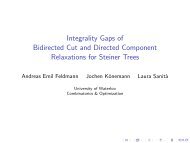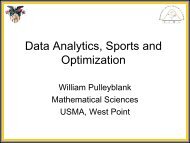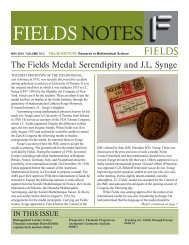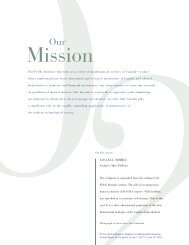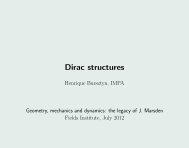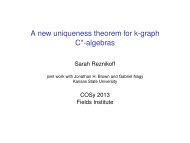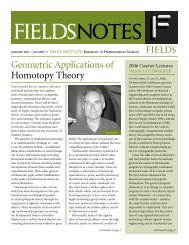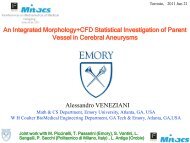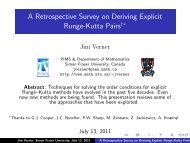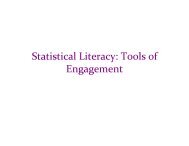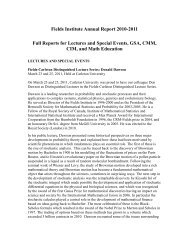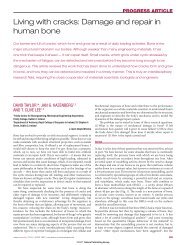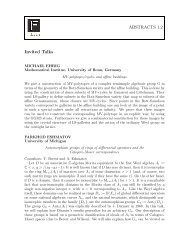Annual Report 2005 - Fields Institute - University of Toronto
Annual Report 2005 - Fields Institute - University of Toronto
Annual Report 2005 - Fields Institute - University of Toronto
Create successful ePaper yourself
Turn your PDF publications into a flip-book with our unique Google optimized e-Paper software.
Speakers:<br />
Roberto Aldave and Simon Gluzman (Generation 5)<br />
Prediction <strong>of</strong> real variables with non-polynomial approximants<br />
David Banks (Duke)<br />
Scalability <strong>of</strong> models in data mining<br />
Yoshua Bengio (Montréal)<br />
Statistical learning from high dimensional and complex data:<br />
not a lost cause<br />
Merlise Clyde (Duke)<br />
Bayesian perspectives on combining models<br />
Adele Cutler (Utah State)<br />
Random forests: proximity, variable importance, and visualization<br />
Alex Depoutovitch (Generation 5)<br />
The use <strong>of</strong> grid computing to speed up prediction<br />
Jerome H. Friedman (Stanford)<br />
Importance sampling: an alternative view <strong>of</strong> ensemble learning<br />
Wenxue Huang (Generation 5)<br />
Dependence degree and feature selection for categorical data<br />
Grigoris Karakoulas (<strong>Toronto</strong>)<br />
ROC-based learning for imbalanced class problems<br />
Theodora Kourti (McMaster)<br />
Data mining in industry for process and product improvement<br />
Helmut Kroeger (Laval)<br />
Learning in neural networks with small-world architecture<br />
Xianping Liu (Generation 5)<br />
Generation 5 hybrid clustering system and its application<br />
Joaquín Ordieres Meré (U. la Rioja)<br />
Data-Mining for industrial processes<br />
Saharon Rosset and Ji Zhu (Michigan)<br />
II regularization: efficient and effective<br />
T h e N a t i o n a l P r o g r a m o n<br />
C o m p l e x D a t a S t r u c t u r e s<br />
Russell Steele (McGill)<br />
Algebraic geometry and model selection for naive Bayes networks<br />
Godfried T. Toussaint (McGill)<br />
Proximity graph methods for data mining<br />
Steven Wang (York)<br />
Clustering categorical data based on distance vectors<br />
S. Stanley Young (NISS)<br />
Linking and pattern matching in multiple large data two-way<br />
tables<br />
Ruben Zamar (UBC)<br />
Robust methods and data mining<br />
Ji Zhu (Michigan)<br />
Piecewise linear SVM paths<br />
Mu Zhu (Waterloo)<br />
An adaptive radial basis function network model for statistical<br />
detection<br />
Djamel A. Zighed (U. Lyon 2)<br />
Constructing induction graphs<br />
Alex Zolotovitski (Generation 5)<br />
Automated trade area analysis: case study <strong>of</strong> G5 MWM s<strong>of</strong>tware<br />
application<br />
Workshop on Forest Fires and Point Processes<br />
May 24–28, <strong>2005</strong><br />
Held at the <strong>Fields</strong> <strong>Institute</strong><br />
Organizers: W. John Braun (UWO), David Martell<br />
(<strong>Toronto</strong>) and Rick Schoenberg (UCLA)<br />
Forest fires are a natural component <strong>of</strong> many <strong>of</strong> Canada’s<br />
forested ecosystems but they also pose threats to public<br />
safety, property and forest resources. Every year, forest fires<br />
cause millions <strong>of</strong> dollars worth <strong>of</strong> damage and force the<br />
evacuation <strong>of</strong> some communities. Such problems will be<br />
exacerbated as people establish more homes and cottages<br />
in and near forested areas and climate change alters forest<br />
vegetation and weather.<br />
The purpose <strong>of</strong> the workshop was to bring together forestry<br />
researchers and statisticians to identify areas <strong>of</strong> potential<br />
collaboration. The meeting was supported by <strong>Fields</strong>,<br />
<strong>Fields</strong> <strong>Institute</strong> <strong>2005</strong> ANNUAL REPORT 50



